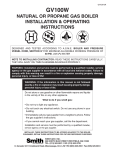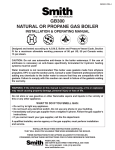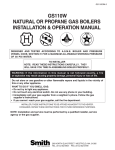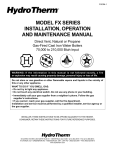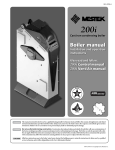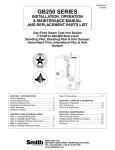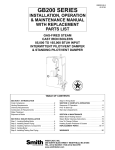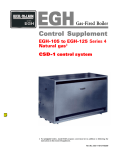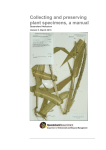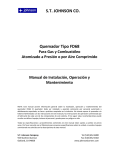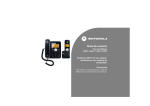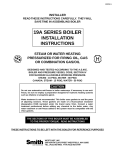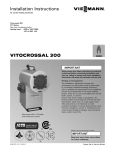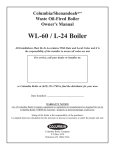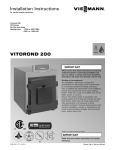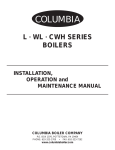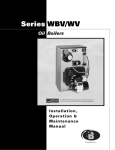Download Smith Cast Iron Boilers 28HE User's Manual
Transcript
28HE-IOM-1 SERIES 28HE GAS OR OIL BOILER INSTALLATION & OPERATING INSTRUCTIONS DESIGNED AND TESTED ACCORDING TO A.S.M.E. BOILER AND PRESSURE VESSEL CODE, SECTION IV FOR A MAXIMUM ALLOWABLE WORKING PRESSURE OF: 15 PSI STEAM OR 80 PSI WATER. TO INSTALLER NOTE: READ THESE INSTRUCTIONS CAREFULLY. THEY WILL SAVE YOU VALUABLE TIME WHEN ASSEMBLING THE BOILER. WARNING: If the information in this manual is not followed exactly, a fire or explosion may result causing property damage, personal injury or loss of life. Do not store or use gasoline or other flammable vapors and liquids in the vicinity of this or any other appliance. WHAT TO DO IF YOU SMELL GAS: • Do not try to light any appliance. • Do not touch any electrical switch. Do not use any phone in your building. • Immediately call your gas supplier from a neighbor’s phone. Follow the gas supplier’s instructions. • If you cannot reach your gas supplier, call the fire department. Installation and service must be performed by a qualified installer, service agency or the gas supplier. INSTALLER, THESE INSTRUCTIONS TO BE AFFIXED ADJACENT TO THE BOILER. CONSUMER, RETAIN THESE INSTRUCTIONS FOR FUTURE REFERENCE PURPOSES. FOR JACKET ASSEMBLY AND BURNER SET UP SEE SEPARATE INSTRUCTIONS. WESTCAST, INC. 260 NORTH ELM STREET WESTFIELD, MA 01085 TEL. (413) 562-9631 FAX (413) 562-3799 In Canada: 5211 Creekbank Road, Mississauga, Ont. L4W 1R3 (905) 625-2991 Fax (905) 625-6610 Page 2 SERIES 28HE BOILER INSTALLATION AND OPERATION INSTRUCTIONS CONTENTS Before You Start ................................................. page 2 Boiler Ratings & Capacities ................................ page 2 Boiler Location ................................................... page 2 Combustion Air & Ventilation .............................. page 3 Chimney & Vent Pipe Connections .................... page 4 Common Vent Systems ...................................... page 6 Boiler Assembly ................................................ page 7 General Piping Requirements .......................... page 14 Water Boiler Piping .......................................... page 15 Steam Boiler Piping .......................................... page 18 Burner Installation ............................................ page 21 Electrical Wiring ............................................... page 22 Boiler Operation .............................................. page 22 Boiler Checking & Adjustment .......................... page 23 Boiler Maintenance .......................................... page 24 Repair Parts ..................................................... page 25 Health Warnings .......................................... back cover BEFORE YOU START This manual covers the assembly, installation, operation and maintenance of a Series 28HE low pressure steam or hot water boiler. The 28HE Series boilers are supplied completely knocked down for field assembly, knocked down but with an assembled block or as complete factory assembled packaged boilers. All boiler components should be inspected for damage upon receipt. Any damage should be immediately reported to the trucker or wholesaler. All boiler components should be stored in a clean dry area. To obtain the safe, dependable, efficient operation and long life for which this boiler was designed, these instructions must be read, understood and followed. In Canada, the installation must be in accordance with the requirements of CAN/CGA B149.1 or .2, Installation Code for Gas Burning Appliances and Equipment. In the Commonwealth of Massachusetts the installation of a gas burner must be performed by a licensed plumber or gas fitter. The owner should maintain a record of all service work performed with the date and a description of the work done. Include the name of the service organization for future reference. Direct all questions to your Smith Cast Iron Boiler distributor or contact the Smith Customer Service Department. Always include the model and serial numbers from the rating plate of the boiler in question. BOILER RATINGS & CAPACITIES Before undertaking the installation of the 28HE Series boiler check the boiler rating plate to ensure that the boiler has been sized properly for the job. The “Net I=B=R Ratings” specify the equivalent amount of direct cast iron radiation that the boiler can supply under normal conditions. Also ensure that the boiler has been set up for the type of fuel available at the installation site. BOILER LOCATION 1. Locate the boiler in an area that provides good access to the unit. A minimum distance of 6 in, 0.15m must be maintained between the boiler and combustible construction. Servicing may require the removal of jacket panels so service clearances should be maintained. Allow a minimum clearance of 3 ft, 0.9 m between adjacent construction and the left side, front and smoke hood. A minimum clearance of 2 ft, 0.6 m should be maintained between adjacent construction and the right side and back of the boiler. Accessibility clearances should take precedence over minimum clearances to combustible construction, Figure 1. 2. An optimum site will be level, central to the piping system, close to a chimney and have adequate fresh air for combustion. 3. The boiler should be installed on a level, flat, concrete floor or pad that is structurally sound and will support the weight of the boiler. If a concrete pad is used it must be at least 2" thick. Never install the boiler on a concrete floor or pad that contains wires, cables, water pipes or hoses. This boiler is designed for non combustible floors! The Series 28HE boilers have been design certified by CSA. Each unit has been constructed and hydrostatically tested for a maximum working pressure of 15 psi for steam, 80 psi for water, in accordance with Section IV of the A.S.M.E. Boiler and Pressure Vessel Code for cast iron boilers. All aspects of the boiler installation must conform to the requirements of the authority having jurisdiction, or, in the absence of such requirements, to the National Fuel Gas Code, ANSI Z223.1/NFPA 54-latest revision or to the Installation of Oil Burning Equipment, ANSI/NFPA 31. Where required by the authority having jurisdiction, the installation must conform to the Standard for Controls and Safety Devices for Automatically Fired Boilers, ANSI/ASME CSD-1. SERIES 28HE BOILER INSTALLATION AND OPERATION INSTRUCTIONS Page 3 Figure 1 -Service Clearances to Adjacent Construction WARNING: Never install a 28HE boiler on top of combustible flooring without consulting the local building authorities for proper installation guidelines! A minimum clearance of 6 in, 0.15 m must be maintained between the boiler and combustible construction. Failure to comply with this warning may result in a fire causing extensive property damage, severe personal injury or death! 4. DO NOT install this boiler in a location that would subject any of the electrical components to direct contact with water or excessive moisture during operation or servicing. 5. DO NOT place this boiler in a location that would restrict the introduction of combustion air into the boiler. WARNING: Never store combustible materials, gasoline or any product containing flammable vapors or liquids in the vicinity of the boiler. Failure to comply with this warning can result in an explosion or fire causing extensive property damage, severe personal injury or death! COMBUSTION AIR & VENTILATION WARNING: This boiler must be supplied with combustion and ventilation air in accordance with Section 5.3, Air for Combustion & Ventilation, of the latest revision of the National Fuel Gas Code, ANSI Z223.1/NFPA 54 and all applicable local building codes. Canadian installations must comply with CAN/CGA B149.1 or .2 Installation Code. Failure to provide adequate combustion air for this boiler can result in excessive levels of carbon monoxide which can result in severe personal injury or death! To operate properly and safely this boiler requires a continuous supply of air for combustion. An adequate supply of air must be available to replace the air used by the combustion process. NEVER store objects on or around the boiler. CAUTION: Never use an exhaust fan in the boiler room. The boiler room must never be under a negative pressure or improper burner operation will occur! NOTE: Forced make-up air supplied to the boiler room must be approved by the local authorities. A minimum of 30 ft 3 /GAL, 0.22 m 3 /L for oil or 20 ft3/100 MBH (Therm), 0.024 m3/kW for gas must be provided. Page 4 SERIES 28HE BOILER INSTALLATION AND OPERATION INSTRUCTIONS All Air From Inside The Buidling If the boiler is to be located in a confined space minimum clearances of 24 in, 610 mm must be maintained between the boiler and any adjacent construction. When installed in a confined space, two permanent openings communicating with an additional room(s) are required. The combined volume of these spaces must have sufficient volume to meet the criteria for an unconfined space. The total air requirements of all fuel burning equipment or any type of exhaust fan must be considered when making this determination. Each opening must have a minimum free area of 1 in2/ 1000 Btu/hr, 140 in2/GPH, 2200 mm2/kW based on the total input rating of ALL fuel burning equipment in the confined area. Each opening must be no less than 100 in2, 64,516 mm2 in size. The upper opening must be within 12 in, 305 mm of, but not less than 3 in, 76 mm from, the top of the enclosure. The bottom opening must be within 12 in, 305 mm of, but not less than 3 in, 76 mm from, the bottom of the enclosure. All Air From Outside The Building When installed in a confined space Two permanent openings communicating directly with, or by ducts to, the outdoors or spaces that freely communicate with the outdoors must be present. The upper opening must be within 12 in, 305 mm of, but not less than 3 in, 76 mm from, the top of the enclosure. The bottom opening must be within 12 in, 305 mm of, but not less than 3 in, 76 mm from, the bottom of the enclosure. Where directly communicating with the outdoors or communicating with the outdoors through vertical ducts, each opening shall have a minimum free area of 1 in2/ 4000 Btu/hr, 35 in2/GPH, 550 mm2/kW of the total input rating of all of the equipment in the enclosure. Where communicating with the outdoors through horizontal ducts, each opening shall have a minimum free area of 1 in2/2000 Btu/hr, 70 in2/GPH, 1100 mm2/ kW of the total input rating of all of the equipment in the enclosure. When ducts are used, they must have the same cross-sectional area as the free area of the opening to which they connect. When calculating the free area necessar y to meet the make-up air requirements of the enclosure, consideration must be given to the blockage effects of louvers, grills and screens. Screens must have a minimum mesh size of 1/4 in, 6.4mm. If the free area through a louver or grill is not known the louver or grille should be sized per Table 1. Table 1 - Make-up Air Louver Sizing Required Cross Sectional Area (in2) Metal Wooden Input 1/4" Wire Louvers Louvers (MBH) Screen 75% Free Area 25% Free Area 1000 250 333 1000 1200 300 400 1200 1400 350 467 1400 1600 400 533 1600 1800 450 600 1800 2000 500 667 2000 2200 550 733 2200 2400 600 800 2400 2600 650 867 2600 2800 700 934 2800 3000 750 1000 3000 3200 800 1066 3200 3400 850 1134 3400 3600 900 1200 3600 3800 950 1267 3800 4000 1000 1334 4000 4200 1050 1400 4200 4400 1100 1467 4400 4600 1150 1533 4600 4800 1200 1600 4800 CHIMNEY & VENT PIPE CONNECTIONS WARNING: The vent installation must be in accordance with Part 7, Venting of Equipment, of the National Fuel Gas Code, ANSI Z223.1/ NFPA 54-latest revision, the ASHRAE Equipment Handbook on Venting or applicable provisions of the local building codes. Canadian installations must comply with CAN/CGA B149.1 or .2 Installation Code. Improper venting of this boiler can result in excessive levels of carbon monoxide which can result in severe personal injury or death! CAUTION: The products of combustion from a 28 HE must be safely vented to the outdoors while ensuring that the flue gasses do not cool prematurely. It’s critical that the chimney system be properly designed to handle the relatively cool flue gas temperatures. An oversized or uninsulated chimney will cause the moisture in the flue gases to condense resulting in damage to the chimney system unless it’s specifically designed for condensate. If this is the case a suitable condensate drain must be used to protect the boiler from condensate. NOTE: Our warranty does not cover corrosion damage to the boiler or its vent system caused by flue gas condensate! SERIES 28HE BOILER INSTALLATION AND OPERATION INSTRUCTIONS Page 5 Chimney Inspection & Sizing If this boiler will be connected to a masonry chimney, a thorough inspection of the chimney must be performed. Ensure that the chimney is clean, properly constructed, lined and properly sized, see Figure 2. Table 2 lists the equivalent breeching and flue sizes required for the 28HE boilers. The 28HE is designed for pressurized operation with a back pressure of 0.10 in, 2.54 mm W.C. before the smoke hood slide damper. If the vent configuration results in a back pressure greater than this, the burner capacity may have to be verified. Contact the Smith Technical Service Department to verify the burner capacity. Table 2 - Equivalent Breeching & Chimney Size Boiler Model Breeching Size Chimney Size in mm in mm 28HE-4 10 254 10 254 28HE-5 10 254 10 254 28HE-6 10 254 10 254 28HE-7 12 305 12 305 28HE-8 12 305 12 305 28HE-9 14 356 14 356 28HE-10 14 356 14 356 28HE-11 14 356 14 356 28HE-12 14 356 14 356 28HE-13 14 356 14 356 28HE-14 16 406 16 406 28HE-15 16 406 16 406 28HE-16 16 406 16 406 28HE-17 18 406 18 406 28HE-18 18 457 18 457 Note: These sizes are based on a 20 foot chimney height. The chimney must be able to provide 0.10" WC at the boiler outlet. If the chimney is 50 ft. or taller it may produce excessive draft (appox. - 0.25" WC) and a barometric draft regulator may be needed. Figure 2- Vertical Venting When more than one appliance is connected to the same chimney flue the flue must be large enough to safely vent the combined output of all the appliances. WARNING: If an appliance using any type of a mechanical draft system operating under positive pressure is connected to a chimney flue, never connect a Category I appliance to this flue. Doing so can result in the accumulation of carbon monoxide which can cause severe personal injury or death! Page 6 SERIES 28HE BOILER INSTALLATION AND OPERATION INSTRUCTIONS VENT CONNECTIONS WARNING: Never modify or alter any part of the boiler’s smoke hood. This includes the removal or alteration of any baffles. Never install a vent pipe of a diameter different than that of the boiler smoke hood outlet. Failure to comply with this warning can result in severe personal injury or death. Locate the boiler as close to the chimney as possible. Use the shortest, straightest vent connector possible for the installation. If horizontal runs exceed 5 ft, 1.5 m they must be supported at 3 ft, 0.9 m intervals with overhead hangers. Use a single wall stainless or single wall galvanized steel vent pipe the same diameter as the flue collar to connect the boiler to a masonry chimney. When using an approved metal chimney system use the appropriate vent connector. The vent connector should be sloped up toward the chimney at a minimum rate of 1/4 in/ft, 2 cm/m. On masonry chimneys the connector must terminate flush with the inside of the chimney flue. Fasten each single wall vent connection with at least 3 corrosion resistant sheet metal screws. The vent materials used in positive pressure vent systems must be certified to UL 1738 for installations in the United States, ULS636 for installations in Canada. The following manufactures have systems that meet these requirements: Heat-Fab, Inc. 38 Hayward Street Greenfield, MA 01301, (800) 772-0739. Z-Flex U.S., Inc. 20 Commerce Park North, Bedford, NH 03110-6911, (800) 654-5600. Protech Systems Inc. 26 Gansevoort Street Albany, NY 12202 (518) 463-7284 WARNING: Breeching under positive pressure must be certified to UL 1738 for installations in the United States, ULS636 for installations in Canada. Type B1 vent SHALL NOT be used. Failure to comply with this warning can result in severe personal injury or death. Always provide a minimum clearance of 6 inches between single wall metal vent pipe and all combustible materials. WARNING: Failure to maintain minimum clearances between vent connectors and any combustible material can result in a fire causing extensive property damage, severe personal injury or death! COMMON VENT SYSTEMS If an existing boiler is removed from a common venting system, the common venting system may then be too large for the proper venting of the remaining appliances connected to it. At the time of removal of an existing boiler, the following steps shall be followed with each appliance remaining connected to the common venting system placed in operation, while the other appliances remaining connected to the common venting system are not in operation. Au moment du retrait d'une chaudière existante, les mesures suivantes doivent être prises pour chaque appareil toujours raccordé au système d'évacuation commun et qui fonctionne alors que d'autres appareils toujours raccordés au système d'évacuation ne fonctionnent pas: système d'évacuation a) Seal any unused openings in the common venting system. Sceller toutes les ouvertures non utilisées du système d'évacuation. b) Visually inspect the venting system for proper size and horizontal pitch and determine there is no blockage or restriction, leakage, corrosion and other deficiencies which could cause an unsafe condition. Inspecter de façon visuelle le système d'évacuation pour déterminer la grosser et l'inclinaison horizontale qui conviennent et s'assurer que le système est exempt d'obstruction, d'étranglement de fruite, de corrosion et autres défaillances qui pourraient présenter des risques. SERIES 28HE BOILER INSTALLATION AND OPERATION INSTRUCTIONS Page 7 c) Insofar as is practical, close all building doors and windows and all doors between the space in which the appliances remaining connected to the common venting system are located and other spaces of the building. Turn on clothes dryers and any appliance not connected to the common venting system. Turn on any exhaust fans, such as range hoods and bathroom exhaust, so they will operate at maximum speed. Do not operate a summer exhaust fan for a boiler installation. Close fireplace dampers. g) Any improper operation of the venting system should be corrected so the installation conforms with the National Fuel Gas Code, ANSI Z223.1/NFPA 54. When resizing any portion of the common venting system, the common venting system should be resized to approach the minimum size as determined using the appropriate tables in Appendix F in the National Fuel Gas Code, ANSI Z223.1/NFPA 54 and or CSA B149 Installation Codes. Dans la mesure du possible, fermer toutes les portes et les fenêtres du bâtiment et toutes les portes entre l'espace où les appareils toujours raccordés du système d'évacuation sont installés et les autres espaces du bâtiment. Mettre en marche les sécheuses, tous les appareils non raccordés au système d'évacuation commun et tous les ventilateurs d'extraction comme les hottes de cuisinère et les ventilateurs des salles de bain. S'assurer que ces ventilateurs fonctionnent à la vitesse maximale. Ne pas faire fonctionner les ventilateurs d'été. Fermer les registres des cheminées. Tout mauvais fonctionnement du systéme d'évacution commun devrait étré corrigé de façor que l'installation soit conforme au National Fue Gas Code, ANSI Z223.1/NFPA 54 et (ou) aux codes d'installation CAN/CGA-B149. Si la grosseur d'une section du système d' évacuation doit étré modifiée, le système devrait étré modifié pour respecter les valeurs minimales des tableaux pertinents de l'appendice F du National Fuel Gas Code, ANSI Z223.1/NFPA 54 et (ou) des codes d'installation CSA-B149. d) Place in operation the appliance being inspected. Follow the lighting instructions. Adjust thermostat so appliance will operate continuously. Mettre l'appareil inspecté en marche. Suivre les instructions d'allumage. Régler le thermostat de façon que l'appareil fonctionne de façon continue. e) Test for spillage at the draft hood relief opening after 5 minutes of main burner operation. Use the flame of a match or candle, or smoke from a cigarette, cigar or pipe. Faire fonctionner le brûleur principal pendant 5 min ensuite, déterminer si le coupetirage déborde à l'ouverture de décharge. Utiliser la flamme d'une allunette ou d'une chandelle ou la fumée d'une cigarette, d'un cigare ou d'une pipe. f) After it has been determined that each appliance remaining connected to the common venting system properly vents when tested as outlined above, return doors, windows, exhaust fans, fireplace dampers and any other gas-burning appliance to their previous condition of use. Une fois qu'il a été d éterminé, selon la métode indiquée cidessus, que chaque appareil raccordé au système d'évacuation est mis à l'air libre de façor adéquate. Remettre les portes et les fenêtres, les ventilateurs, les registres de cheminées et les appareils au gaz à leur position originale. BOILER ASSEMBLY Locate the boiler installation site based on the guidelines set forth in the BOILER LOCATION section. WARNING: Never install a 28HE boiler on top of comustible flooring without consulting the local building authorities for proper installation guidelines! Failure to comply with this warning can result in a fire causing extensive property damage, severe personal injury or death! Packaged Boilers/Factory Assembled Sections A careful inspection of all assemblies should be made to detect possible shipping damage. Packaged boilers and factor y assembled blocks of sections are hydrostatically tested at the factory to insure pressure tightness. A hydrostatic retest should be performed before any piping connections are made to detect leaks caused by shipping. NOTE: All assembled boiler sections shall pass the hydrostatic tests prescribed in Section IV of the ASME Boiler and Pressure Vessel Code. CAUTION: Do not connect any boiler controls during the pressure test or they will be damaged! Page 8 SERIES 28HE BOILER INSTALLATION AND OPERATION INSTRUCTIONS Completed boilers must be tested as follows: 2. Steam Boilers – the assembled boiler sections shall be subjected to a hydrostatic test pressure of not less than 45 psig, 315 kPa. Water Boilers – the assembled boiler sections shall be subjected to a hydrostatic test pressure of not less than 1 1/2 times the maximum allowable working pressure. Carefully place the back section in position on the angles as shown in Figure 4. WARNING: The section MUST be fully supported to prevent it from falling! Failure to comply with this warning may result property damage, severe personal injury or death! Figure 4 - Section Placement The hydrostatic pressure shall not exceed the required test pressure by more than 10 psig, 70 kPa during the test. WARNING: Never leak test the boiler using compressed air! Failure to comply with this warning may result in property damage, severe personal injury or death! 1. Plug all openings in the boiler and fill it with water. 2. Bleed any air off through one of the top tappings then increase the pressure as outlined above. 3. Maintain the test pressure while carefully checking for leaks. If a leak is found it must be eliminated, see Table 4 and suppor ting text. Once the assembled boiler sections pass the hydrostatic test drain them and remove the plugs from any tappings that will be used in service. NOTE: The shipping lugs, lifting lugs and metal banding should be removed before installing the jacket on factory assembled sections. 3. Clean the hydronic port connector sealing surfaces and the rope grooves with a wire brush to remove any rust or debris. 4. Apply two coats of the spray adhesive supplied with the boiler to the rope groove. Allow time for the first coat to dry before applying the second coat. When the second coat is tacky press the rope into the rope groove. Trim the rope off leaving 1/8 in., 3.2 mm extending beyond the surface of the cast iron section, Figure 5. Figure 5 - Rope Installation CAUTION: Remove the left jacket panels on fully packaged boilers and ensure that the cleanout covers are secure and gas tight. Loose covers could damage the boiler. Assembly of Knocked-Down Boilers Drilled and tapped steel angles are furnished to provide a level footing, ease of section assembly and a point of jacket attachment. 1. Set the angles as shown in Figure 3. They must be parallel and level. Grout under the angles to provide a continuous bearing surface. Figure 3 - Steel Angle Placement SERIES 28HE BOILER INSTALLATION AND OPERATION INSTRUCTIONS 5. Insert the large port connector with its steel inner ring into the upper port. 6. Insert the two round port connectors into the lower ports. Page 9 Figure 6 - Section Alignment NOTE: Apply the spray adhesive supplied with the boiler to the port recess to hold the port connector in place if necessary. 7. Select the correct intermediate section and carefully move it into place against the back section, Figure 4. CAUTION: Any steam uptake and heater sections must be located as shown in Table 3. Failure to comply with this caution may result in poor boiler performance and prevent the jacket from fitting! Only one intermediate section with an external leg boss has been included. It should be located toward the front of the boiler for optional low water cutoff use. See Table 3. NOTE: A putty knife or similar tool can be used to hold the port connectors in place while the intermediate section is positioned. It must be removed before the sections make contact or the port connector will be damaged resulting in a leak! 8. Insert the four draw rods through the casting bosses. Thread nuts onto one end of the rods. Place washers on the other end of the rods before threading nuts onto them. Snug the nuts finger tight. Use a spirit level to ensure that the first two sections are plumb and properly aligned, Figure 6. Check the rope to insure that it’s properly positioned. Once the sections are plumb and the rope and por t connectors are properly positioned follow the torque sequence shown in Table 4. Table 4 - Section Torque Sequence Step Rod Position Torque ft lbs Nm 1 Upper Right 25 34 2 Lower Left 25 34 3 Lower Right 25 34 4 Upper Left 10 14 5 Upper Right 50 68 6 Lower Left 50 68 7 Lower Right 50 68 8 Upper Right 75 102 9 Lower Left 75 102 10 Lower Right 75 102 11 Upper Left 30 42 12 Upper Right 125 169 13 Lower Left 125 169 14 Lower Right 125 169 15 Upper Right 125 169 16 Upper Left 40 54 NOTE: With these initial torques the sections may not be metal to metal, which is acceptable. If any of the ports leak during the hydrostatic test the torque can be increased to 200 ft lbs, 271 Nm on the upper right rod. The torque on the lower left and right rods can be increased to 150 ft lbs, 203 Nm. Once the sections are metal to metal additional torque will not improve the seal. Table 3 - Section Locations Boiler Model 28HE-4 28HE-5 28HE-6 28HE-7 28HE-8 28HE-9 28HE-10 28HE-11 28HE-12 28HE-13 28HE-14 28HE-15 28HE-16 28HE-17 28HE-18 1 F F F F F F F F F F F F F F F 2 T H T T T T H H H H H H H H H 3 H T H H H H T T T T T T T T T 4 B H T P P P H H H H H H H H H 5 6 B H T H H P P P P P P P P P B H T P H T T H H H H H H Section Location Numbered From Front To Back 8 9 10 11 12 13 14 15 16 17 F Front Section T Intermediate Section w/ 5" Tapping & Boss H Intermediate Section w/ Heater Opening B P Intermediate Section, Plain H B B Back Section T H B P T H B P T H B H P H T H B T P P H T H B T H P H P T H B P T H P H P T H B P H T H P H P T H B P H T H P H P H T H B P H P T H P H P H T H 7 18 B Page 10 9. SERIES 28HE BOILER INSTALLATION AND OPERATION INSTRUCTIONS Assemble the rest of the sections following steps 3 through 8 above. Figure 8 - Cleanout Cover Assembly 10. Hydrostatically test the boiler by following the instructions on page 8. 11. While the boiler is being filled confirm that all of the draw rods are properly torqued and that there are no leaks. 12. If any leaks are found tighten the draw rods on that section until the leak stops. Heat Transfer Rod Installation, Figure 7 The high efficiency 28HE comes with design certified heat transfer rod sets. Each tube of 15 heat transfer rods will baffle one flue. In order to obtain the high efficiency for which the boiler was designed, the heat transfer rods must be properly installed, Figure 7. Figure 7 -Heat Transfer Rod Installation Burner Mounting Plate Installation, Figure 9 1. Apply two coats of the spray adhesive supplied with the boiler to the rope groove on the plate. Allow time for the first coat to dry then apply the second coat. When the second coat is tacky lay the 3/8" rope into the rope groove and press in place. Cleanout Cover Installation 1. The cleanout covers come insulated from the factory. Inspect the covers to ensure that the insulation is not damaged or missing. If it is call the Smith Customer Service Department. 2. Trim the 1/2" rope that’s sticking out around the cleanout opening flush with the castings to insure an air-tight seal, see Figure 5. 3. Install the cleanout cover bolts from the baffled side of the cleanout cover and start the nuts, Figure 8. 4. Rotate the bolts so the cam heads fit between the cleanout cover bosses on the castings. 5. Insert the cleanout cover and tighten the nuts to 15 ft lbs, 21 Nm. 6. Apply a bead of high temperature silicone caulk around the perimeter of the cleanout cover to ensure an air tight seal. 2. Screw the four 7/16-14 x 2 1/2" studs into the tapped holes in the boiler front section, Figure 9. 3. Install the burner mounting plate insulation block in the burner opening in the front section of the boiler. The small observation port cutout must be on the top, left side. 4. Position the front jacket panel frame over the four studs, Figure 9. 5. Align the four holes in the burner mounting plate with the 7/16" studs and force the burner insulation block inward until the studs extend far enough through the burner mounting plate holes so the nuts can be started. Lightly tighten the nuts. 6. Carefully insert the 1/4-20 x 5" machine screws through the holes in the burner mounting plate and insulation block, Figure 9. Reach through the inside of the burner opening and install the stainless steel fender washers and nuts and snug the nuts down. CAUTION: The burner insulation block must be supported from the inside to prevent it from tearing. Don't force the bolts through the block or over tighten the nuts or the block with be damaged! SERIES 28HE BOILER INSTALLATION AND OPERATION INSTRUCTIONS Figure 9 - Burner Mounting Plate Details Observation Port Assembly, Figure 10 1. Position the hinged end of the steel flapper door, item 5, over the boss on the observation port cover, item 4. 2. Drive the expansion pin, item 7, through the hinge bosses to secure the door to the cover. 3. Insert the hex bolt, item 6, through the hole in the observation port cover. 4. Install the spring, nut and knob, items 3, 2 & 1 on the bolt as shown. Use the nut, item 2, as a jam nut against the knob, item 1. 5. Apply the insulating tape to the back of the observation port cover as shown. Figure 10 - Observation Port Assembly Page 11 Page 12 SERIES 28HE BOILER INSTALLATION AND OPERATION INSTRUCTIONS Observation Port Installation 1. Screw the four 5/16-18 x 1 1/2" studs into the tapped holes around the observation cover opening in the back section. Smokehood Installation, Figure 11 1. Screw the four 5/16-18 x 1 1/2" studs into the tapped holes around the smokehood opening in the back section. 2. 2. Apply smokehood insulation tape to smokehood. Place the observation port cover assembly over the studs and install the washers and nuts. Tighten the nuts uniformly. Figure 11 - Smokehood Assembly 3. Place the smokehood over the studs and install the washers and nuts. Tighten the nuts uniformly. 4. Apply the 1/8" x 3/4" x 18" strip of insulating tape to the damper anchoring angle, Figure 11. 5. Fully open the slide damper and leave it ready for adjustment during burner light off. SERIES 28HE BOILER INSTALLATION AND OPERATION INSTRUCTIONS Tankless Heater Installation - Optional 1. Clean the heater flange to remove any rust or debris. 2. Install the four 7/16" x 1 1/2" studs into the tapped holes in the tankless heater flange on the section, Figure 12. Figure 12 - Tankless Heater Installation 5. Page 13 Install the operating control in one of the heater mounting plates to ensure quick burner response when there is a demand for hot water. Figure 13 illustrates an acceptable piping arrangement for multiple heaters. Burner Mounting 1. Clean the burner mounting flange to remove any rust or debris. 2. Install the four 3/8" x 1 1/4" studs into the tapped holes in the burner mounting plate. 3. Use a hacksaw blade, or some other suitable tool, to properly size the opening in the burner mounting plate insulation block to match the burner air tube end diameter. NOTE: The opening should be a close fit, but not too snug or the insulation block may be damaged upon burner insertion! 4. 3. Place the heater gasket over the studs and carefully install the heater. 4. Install the nuts and tighten evenly to ensure uniform compression of the gasket. Place the burner gasket, supplied with the burner, over the studs and carefully insert the burner into the opening in the burner mounting plate. CAUTION: Most burners require support to the floor. Follow the burner manufacturer's instructions or the burner may be damaged! 5. Install the 3/8" washers and nuts and tighten securely. Figure 13 - Multiple Tankless Heater Piping Page 14 SERIES 28HE BOILER INSTALLATION AND OPERATION INSTRUCTIONS GENERAL PIPING REQUIREMENTS Figure 15 - Back Section Tapping Locations CAUTION: Never use automotive antifreeze in the boiler or heating system. If antifreeze is necessary it must be formulated specifically for hydronic heating systems, such as ethylene or propylene glycol. Failure to comply with this caution will void the warranty! All heating system piping must be installed by a qualified technician in accordance with the latest revision of the ANSI/ASME Boiler and Pressure Vessel Code, Section IV. Also ANSI/ASME CSD-1, Standard for Controls and Safety Devices for Automatically Fired Boilers where required. All applicable local codes and ordinances must also be followed. A minimum clearance of 1" must be maintained between heating system pipes and all combustible construction. CAUTION: Improper piping of this boiler can result in poor performance and premature failure of the boiler voiding the warranty! Improper piping can also cause flooding and extensive property damage! Ensure that the boiler is level from front to back and from side to side. Use metal shims to level the boiler. NEVER use wood, plastic or other combustible materials as shims. Table 5 - Water & Steam Tappings Tapping 1 2 3 4 Size 1/8" 3/4" 3/4" 3/4" NOTE: Install the observation port assembly before making any return piping connections as access may be blocked by piping. 5 3/4" 6 7 1" 6" Figure 14 - Front Section Tapping Locations 8 3/4" If a boiler is installed above any radiation elements it must be fitted with a low water cutoff device. 9 10 11 12 13 Water Chamber Pressure Temp./Pressure Gage Operating Control - Top Manuel Reset High Limit Air Removal Water Supply Tankless Heater Operating Control Steam Chamber Pressure Probe LWCO Water Glass Manuel Reset High Limit & Steam Gage Water Column - Top Skim Tapping 1 1/2" Inspection Tapping - Top 1" Water Column - Bottom Water Column - Bottom 4" Boiler Drain Boiler Drain/Blowoff 4" Return Return Relief Valve Safety Valve Relief & Safety Valve Piping Install the pressure relief or safety valve in the 3" NPT opening in the top of the back section, Figure 14. WARNING: The discharge of the pressure relief or safety valve must be piped close to the floor to prevent scalding in the event of a discharge, see Figure 16. The discharge piping must be sized the same as the pressure relief or safety valve outlet. Never install any type of valve between the boiler and the pressure relief or safety valve! Failure to comply with this warning can result in an explosion causing extensive property damage, severe personal injury or death! SERIES 28HE BOILER INSTALLATION AND OPERATION INSTRUCTIONS Figure 16 - Relief & Safely Valve Piping Table 7- Boiler Water Content Boiler Model Water Boilers Gallons Liters 28HE-4 123 466 28HE-5 150 568 28HE-6 177 670 28HE-7 204 772 28HE-8 231 875 28HE-9 258 977 28HE-10 285 1079 28HE-11 312 1181 28HE-12 339 1283 28HE-13 366 1386 28HE-14 392 1484 28HE-15 419 1586 28HE-16 446 1689 28HE-17 473 1791 28HE-18 500 1893 Page 15 Steam Boilers Gallons Liters 104 394 126 477 148 560 170 644 192 727 214 810 236 893 258 977 280 1060 302 1143 324 1227 346 1310 368 1393 399 1511 412 1560 Return Piping 10 Through 18 Section Boilers Install two 4" NPT x 6" nipples per Figure 17. Assemble the rest of the return yoke as shown in Figure 17. WATER BOILER PIPING The supply and return connections should be sized to suit the system, see Figures 14, 15, 17, 18 and Tables 5 & 6. Do not pipe the supply from the bottom port or the return to the top port, the boiler will not work properly. Typical water boiler piping arrangements are shown in Figures 19 & 20. Swing joints should be used. Install 3" nipples into the two 3" NPT tappings in the front section and cap them. NOTE: See CLEANING OF WATER BOILERS on page 18 before proceeding! Supply Piping Install a reducing bushing in the 6" NPT tapping in the front section to obtain the correct supply pipe size, Figure 14 and Tables 5 & 6. Table 6 - Water Boiler Piping Boiler Size Return Size # Sections NPT 4&5 3 6 through 9 4 10 through 18 5 Supply Size NPT 3 4 5 Note: Sizes based on 20°F, 11.1°C, ∆T for the system. Return Piping 4 through 9 Section Boilers Install 3" x 4" NPT bushings in the two 4" NPT tappings at the bottom of the back section. Install two 3" NPT x 6" nipples per Figure 17. Assemble the rest of the return yoke as shown in Figure 17. Control Installation Locate the temperature & pressure gage, low water cutoff, high limit and operating controls per Figures 14 & 18. Optional controls must be installed in accordance with the control manufacturers instructions and Figures 14 & 18. Note: The front jacket panel MUST be installed before any controls are attached to the front boiler section! CAUTION: The controls must be mounted in the correct location and according to the control manufacturer’s instructions or the boiler may not function properly! Water Column Piping A variety of water level controls are available for the 28HE. The water column piping needed to properly mount each control is available from Smith. Figure 18 shows a typical water column piping arrangement. The 1" NPT x 7 1/2" nipple is always installed in the lower water column tapping, Figures 14 & 18 and Table 5. Page 16 SERIES 28HE BOILER INSTALLATION AND OPERATION INSTRUCTIONS Piping For Use With Cooling Units The boiler, when used in connection with a refrigeration system, must be installed so the chilled medium is piped in parallel with the boiler. Appropriate valves must be used to prevent the chilled water from entering the boiler, see Figure 21. When a boiler is connected to a heating coil that may be exposed to refrigerated air from an air handling device, the piping system must be equipped with flowcontrol valves or some other automatic means of preventing gravity circulation of the boiler water during the cooling cycle. Figure 17 - Optional Return Yoke Figure 18 - Boiler Control Locations STEAM WATER SERIES 28HE BOILER INSTALLATION AND OPERATION INSTRUCTIONS Figure 19 Typical Single Water Boiler Piping Figure 20 - Typical Multiple Water Boiler Piping Page 17 SERIES 28HE BOILER INSTALLATION AND OPERATION INSTRUCTIONS Page 18 Figure 21 - Chilled Medium Diagram NOTE FOR HEATING: VALVES “H” OPEN, VALVES “C” CLOSED. FOR COOLING: VALVES “H” CLOSED, VALVES “C” OPEN. NOTE: Some locations do not allow this solution to be used. Check with the local authority having jurisdiction. 4. Mix the cleaning chemicals with water to create a concentrated solution. Pour the cleaning solution through one of the top tappings in the front section and plug it. 5. Immediately fill the rest of the boiler and the heating system with water. 6. Fire the boiler and maintain a water temperature of 160°F to 200°F, 71°C to 93°C it may be necessary to cycle the boiler. ROOM UNIT EXP. TANK VENT H RELIEF VALVE C PUMP DRAIN FILL VALVE H 7. Run all of the system pumps during the cleaning procedure. C DRAIN BOILER CHILLER WARNING: Monitor the boiler pressure constantly during the cleaning procedure. Do not allow the boiler pressure to exceed the pressure listed on the pressure relief valve or a discharge of hot water and steam will occur! Cleaning of Water Boilers Normally the cleaning of water boilers is unnecessary unless there is unusually heavy contamination of the boiler or system. The burner must be installed and made operational along with the operating, limit and other safety controls. The burner on oil boilers must be adjusted to prevent sooting of the boiler flues. Final burner adjustment should be made after the boiler has been properly cleaned. WARNING: The pressure relief valve must be installed and piped to the floor to prevent scalding in the event of a discharge, see Figure 16. The discharge piping must be sized the same as the pressure relief valve outlet. Never install any type of valve between the boiler and the pressure relief valve! Failure to comply with this warning can result in an explosion causing extensive property damage, severe personal injury or death! 1. Install ball valves on the two 3" NPT nipples in the bottom of the front section and pipe to a suitable drain. 2. Fill the boiler 3/4 full with water. 3. Make a cleaning solution by mixing 1 lb, 0.45 kg each off caustic soda and trisodium phosphate for every 50 ga, 189 L of water, see Table 7. NOTE: The water content of the heating system must be added to the boiler water content. CAUTION: Avoid skin contact with cleaning solution to prevent injury! If eye or skin contact occurs flush with large quantities of water. 8. Shut the boiler off and allow the boiler to cool to 100°F, 38°C. Open the 3" ball valves and drain the boiler and heating system. 9. Remove the 3" ball valve and install 3" pipe caps in the ends of the 3" NPT nipples. 10. Refill the boiler and heating system with water. STEAM BOILER PIPING Steam Boiler Piping Connections Table 3 contains the steam riser location schedule. Riser, equalizer and header pipe sizes are located in Table 8. A typical single boiler piping arrangement is shown in Figure 22. Figures 23 & 24 contain typical piping diagrams for steam boilers in a battery. NOTE: See CLEANING OF STEAM BOILERS before connecting the return piping. CAUTION: Improper placement of steam risers will result in poor steam quality! Table 8 - Steam Boiler Piping Sizes Boiler Number of Header Model 5" NPT Risers Size, NPT 4&5 1 5" 6&7 2 5" 8 Through 10 2 6" 11 Through 18 3 8" Equalizer Size, NPT 2 1/2" 2 1/2" 4" 4" The steam piping should be pitched so the condensate flows in the direction of steam travel. The return tappings should be yoked to equalize the return flow, Figure 17. Swing joints should be used. SERIES 28HE BOILER INSTALLATION AND OPERATION INSTRUCTIONS Page 19 Table 9 - Steam Boiler Capacities Minimum Feed Water Condensate Receiver I=B=R Gross Output Evaporation Rate Boiler Pumping Rate Capacity Model MBH kW GPM L/hr GPM L/hr Gallons Liters 28HE-S-4 900 264 1.9 7.3 3.9 14.8 37 140 28HE-S-5 1166 342 2.5 9.5 5.0 18.9 48 182 28HE-S-6 1433 420 3.1 11.7 6.2 23.5 59 223 28HE-S-7 1699 498 3.7 13.8 7.3 27.6 69 261 28HE-S-8 1965 576 4.2 16.0 8.4 31.8 80 303 28HE-S-9 2232 654 4.8 18.1 9.6 36.3 91 345 28HE-S-10 2498 732 5.4 20.3 10.7 40.5 102 386 28HE-S-11 2764 810 5.9 22.5 11.9 45.1 113 428 28HE-S-12 3031 888 6.5 24.7 13.0 49.2 124 469 28HE-S-13 3297 966 7.1 26.8 14.2 53.8 135 511 28HE-S-14 3563 1044 7.7 29.0 15.3 57.9 145 549 28HE-S-15 3830 1122 8.2 31.2 16.5 62.5 156 591 28HE-S-16 4096 1200 8.8 33.3 17.6 66.6 167 632 28HE-S-17 4362 1278 9.4 35.5 18.7 70.8 178 674 28HE-S-18 4629 1356 9.9 37.6 19.9 75.3 189 716 Note: These recommendations are considered normal for compact buildings. Where buildings are spread out, additional receiver capacity may be necessary because of the extended time required for condensate to return to the receiver. Figure 22 - Typical Single Boiler Steam Piping Page 20 SERIES 28HE BOILER INSTALLATION AND OPERATION INSTRUCTIONS Figure 23 - Typical Steam Piping - Gravity Return for Multiple Boilers Figure 24 - Typical Steam Piping - Pumped Return for Multiple Boilers SERIES 28HE BOILER INSTALLATION AND OPERATION INSTRUCTIONS Page 21 Install 3" nipples into the two 3" NPT tappings in the front section and install ball valves so the boiler can be blown down. CAUTION: Avoid skin contact with cleaning solution to prevent injury! If eye or skin contact occurs flush with large quantities of water. The feed water requirements for steam boilers at full input are shown in Table 9. The addition of water to the boiler should be controlled by sensing the actual boiler water level. 1" NPT water column tappings are provided on the front section for the mounting of the required water level controls, see Figure 18. NOTE: Some locations do not allow this solution to be used. Check with the local authority having jurisdiction. CAUTION: Makeup water connections must be made to the return piping and not to the boiler or the boiler may be damaged voiding the warranty! 5. Mix the cleaning chemicals with water to create a concentrated solution. Pour the cleaning solution through one of the top tappings in the front section and plug it. 6. Immediately fire the boiler and maintain a steam pressure of 0 to 2 psig, 0 to 13.8 kPa. It may be necessary to cycle the boiler. Cleaning of Steam Boilers The burner must be installed and made operational along with the operating, limit and other safety controls. The burner on oil boilers must be adjusted to prevent sooting of the boiler flues. Final burner adjustment should be made after the boiler has been properly cleaned. CAUTION: Failure to properly clean the boiler can result in foaming and surging and prevent proper operation of the boiler! Boiler damage can occur voiding the warranty! WARNING: Monitor the boiler pressure constantly during the cleaning procedure. Do not allow the boiler pressure to exceed 15 PSI, 103 kPa or a discharge of hot water and steam will occur! 7. Adjust the water feed to prevent the build up of pressure within the boiler. Continue the skimming process until the discharge runs clear. 8. Shut the boiler off and allow the boiler to cool to 100°F, 34°C. Remove the skim piping and plug the tapping. Open the blowdown valve and flush the boiler until the discharge runs clear. 9. Close the blowdown valve and fill the boiler with water to a level 1 in., 25 mm below the normal water level line. NOTE: Do not connect the boiler to the return piping until the system piping has been thoroughly flushed or recontamination of the boiler can occur. 1. Plug the 4" NPT return tappings in the back section and any other unused tappings, see step 5 below. WARNING: The safety valve must be installed and piped to the floor to prevent scalding in the event of a discharge, see Figure 16. The discharge piping must be sized the same as the safety valve outlet. Never install any type of valve between the boiler and the safety valve! Failure to comply with this warning can result in an explosion causing extensive property damage, severe personal injury or death! 2. Fill the boiler with water to a level 1 in., 25.4 mm below the normal water level line of 50 1/2 in., 1.28 m from the floor. 3. Pipe a skimmer off the 6" NPT tapping in the front section using 1 1/2" NPT pipe. 4. Make a cleaning solution by mixing 1 lb, 0.45 kg each off caustic soda and trisodium phosphate for every 50 ga, 189 L of water, see Table 7. 10. Check the traps and vents for proper operation. BURNER INSTALLATION WARNING: The burner must be installed in accordance with the burner manufactures instructions. Check the boiler rating plate to make sure that the boiler is for the type of fuel that will be used. If it isn't, do not connect the burner to the fuel supply. Failure to comply with this warning can result in extensive property damage, severe personal injury or death! Follow the burner manufacturer’s installation instructions for the proper installation, fuel piping, wiring, burner adjustment and servicing. Mount the burner per the instructions on page 13. When applicable, provisions for vent, bleed and gas relief lines must be made in accordance with the latest revision of ANSI Z223.1/NFPA 54. Page 22 SERIES 28HE BOILER INSTALLATION AND OPERATION INSTRUCTIONS WARNING: Never use an open flame to test for gas leaks. Always use an approved leak detection method. Failure to comply with this warning can cause extensive property damage, severe personal injury or death! Whenever the gas supply piping is pressure tested the boiler gas controls must be protected. If the test pressure is equal to, or less than 1/2 psig, 3.5 kPa isolate the boiler by closing the manual shut off valve in the gas supply pipe to the boiler. If the test pressure is greater than, or equal to 1/2 psig, 3.5 kPa, disconnect the boiler and its individual shut-off valve from the gas supply. ELECTRICAL WIRING Electrical Power Connections CAUTION: Label all wires prior to disconnection when servicing controls. Wiring errors can cause improper and dangerous operation! Verify proper operation after servicing. The electrical connections to this boiler must be made in accordance with all applicable local codes and the latest revision of the National Electrical Code, ANSI/ NFPA-70. Installation should also conform with CSA C22.1 Canadian Electrical Code Part I if installed in Canada. Install a separate circuit properly rated for the boiler. A shut-off switch should be located at the boiler. The boiler must be grounded in accordance with the authority having jurisdiction, or if none, the latest revision of the National Electrical Code, ANSI/NFPA-70. Line voltage field wiring of any controls or other devices must conform to the temperature limitation of type T wire at 95°F, 35°C above room temperature. Use copper conductors with a minimum size of #14 awg. BOILER OPERATION WARNING: Before proceeding read and fully understand the instructions contained in this manual. Do not attempt to operate this boiler if it has not been installed in accordance with the guidelines set forth in this manual. Failure to comply with this warning can result in extensive property damage, severe personal injury or death! CAUTION: The supply temperature of a boiler set for a 20°F, 11°C temperature rise must not be below 140°F, 60°C for an oil boiler, 149°F, 65°C for a gas boiler. Failure to protect the boiler from low return water temperatures will damage the boiler, voiding the warranty! Water Boilers Fill the boiler and all of the radiation with water to the required system pressure. Completely purge the system of air and adjust the system pressure as needed. CAUTION: Thermal shock of water boilers must be avoided! Water circulation must be established before the burner is fired. If hot standby is required, special piping and operation procedures are necessary, consult your Smith representative. Failure to protect the boiler from thermal shock can damage the boiler, voiding the warranty! Steam Boilers Fill the boiler with water to the normal water level line of 50 1/2 in., 1.28 m from the floor. If the boiler is connected to a hot steam line, keep the cold boiler valved off line and fire the burner until the boiler pressure exceeds the system pressure by 1 to 2 psig, 7 to 14 kPa. Slowly open the main isolation valve on the boiler to bring it on line. CAUTION: Never place a cold boiler into service on a hot steam line or severe damage to the boiler and piping can occur voiding the warranty! Steam entering a cold boiler will cool quickly and can cause severe steam hammer and boiler flooding. Idle boilers not valved off from the system should have an overflow installed to prevent it from being flooded. If an overflow trap is not installed per Figure 25, and the boiler becomes flooded, the flooded boiler must be heated to a near steaming condition, 210°F, 99°C, then drained to the correct water level. Water and Steam Boilers Follow the burner manufactures lighting instructions that were supplied with the burner. WARNING: Never attempt to start the burner if the combustion chamber contains excess oil or gas, when the boiler is full of vapor or the combustion chamber is very hot. Failure to comply with this warning can result in an explosion causing extensive property damage, severe personal injury or death! A properly adjusted gas burner on high fire will produce a CO2 of 8.5 to 9.5% with a CO level under 300 ppm. When firing on oil at high fire, the burner should be adjusted to produce a CO2 of 11.0 to 12.0% with a zero smoke. The flue gas samples should be taken at the smoke hood. Confirm proper burner adjustment with a calibrated combustion analyzer. SERIES 28HE BOILER INSTALLATION AND OPERATION INSTRUCTIONS CAUTION: If the flue gas temperature exiting the smoke hood is less than 320°F, 160°C at full rated input, the number of heat transfer rods in the boiler must be reduced. Failure to protect the boiler from low flue gas temperatures will shorten the life of the boiler and breeching and void the warranty! Flue Temperature Adjustment 1. Shut the boiler off and remove the left side jacket panels and cleanout covers, Figure 8. 2. Remove the bottom heat transfer rod from each flue. 3. Replace the cleanout covers and fire the boiler for at least 15 minutes. 4. Check the flue temperature. If it’s greater than 320°F, 160°C, reseal the cleanout covers and install the left side jacket panels. 5. If the flue temperature is still less than 320°F, 160°C, repeat steps 1 through 4. Figure 25 - Recommended Overflow Trap Piping Page 23 BOILER CHECKING & ADJUSTMENT CAUTION: Never increase the input to the boiler above that for which it is rated. Doing so can cause premature failure of the boiler! Low Water Cutoff Ensure that the low water cutoff device(s) function(s) properly. Test in accordance with the manufacturer’s instructions included with the device(s). HI Limit The aquastat high limit controls the maximum water temperature in the boiler. It is adjustable from 140°F, 60°C to 240°F, 116°C. If the water temperature reaches the set temperature before the demand for heat has been met, the aquastat high limit should shut the boiler off. The water temperature should never exceed the maximum set point of 240°F, 116°C. The aquastat high limit cannot be repaired. If it fails to function properly replace it. Page 24 SERIES 28HE BOILER INSTALLATION AND OPERATION INSTRUCTIONS BOILER MAINTENANCE WARNING: Servicing, inspection and adjustment of the boiler must be done by a trained technician in accordance with all applicable local and national codes. Improper servicing or adjustment can result in property damage, severe personal injury or death! 9. Inspect the cleanout cover insulation and rope seal. If damaged or deteriorated replace them. 10. Install the clean out covers and reseal them with a silicone caulk rated for 500°F, 260°C. 11. Install the left jacket panels and remount the burner. 12. Restore electrical power and fuel to the boiler. The boiler should be cleaned and inspected once a year, before each heating season. Heat Exchanger Cleaning A flue temperature over 550°F, 288°C, indicates that the boiler needs to be cleaned. 1. Shut off the electrical power and the fuel supply to the boiler. 2. Remove the left side jacket panels. Vent System Thoroughly inspect the vent system for any signs of blockage, corrosion or leakage. Immediately replace any unsound vent system piping. Controls 1. Low water cutoff devices must be serviced per the manufacture’s instructions. 2. 3. Remove the cleanout covers, Figure 8. 4. Remove the heat transfer rods, Figure 7, and clean them with a wire brush if they're dirty. 5. Clean each flue passage with a wire brush. 6. If heavy deposits are present, pull the burner and vacuum out the combustion chamber. 7. Vacuum out the burner base and clean and inspect all of the components. Replace any damaged or badly corroded parts. 8. Install the heat transfer rods in the correct order, Figure 7. The relief valve should vent water when the test lever is lifted. It should not weep or discharge water at normal system pressure. WARNING: Never try to clean or repair the relief valve! If the valve fails to operate properly, replace it! Failure to comply with this warning can result in an explosion causing extensive property damage, severe personal injury or death! 3. Use a combustion analyzer to ensure that the burner is adjusted properly, see BOILER OPERATION. SERIES 28HE BOILER INSTALLATION AND OPERATION INSTRUCTIONS Figure 26 - Boiler Assembly Page 25 Page 26 SERIES 28HE BOILER INSTALLATION AND OPERATION INSTRUCTIONS Ref # Name of Part Part # 4 Number of Sections with Item Quantities Below 5 6 7 8 9 10 11 12 13 14 15 16 17 1 Front Section 3621 1 1 1 1 1 1 1 1 1 1 1 1 1 1 1 2 Graphite Port Connector Set 60375 3 4 5 6 7 8 9 10 11 12 13 14 15 16 17 3 Draw Rod Washers 62099 12 16 20 24 28 32 36 40 44 48 52 56 60 64 68 4 5/8" x 11" Draw Rods 60102 12 16 20 24 28 32 36 40 44 48 52 56 60 64 68 5 Draw Rod Hex Nuts 60877 24 32 40 48 56 64 72 80 88 96 104 112 120 128 136 6 Rope, 1/2" x 12 1/2 feet 70660 3 4 5 6 7 8 9 10 11 12 13 14 15 16 7 Heat Transfer Rod Set 70063 3 4 5 6 7 8 9 10 11 12 13 14 15 16 17 Cleanout Cover Assembly 70360 3 4 5 6 7 8 9 10 11 12 13 14 15 16 17 8(2) 17 9 Cleanout Cover Nut 60245 6 8 10 12 14 16 18 20 22 24 26 28 30 32 34 10 Cleanout Cover Washer 62095 6 8 10 12 14 16 18 20 22 24 26 28 30 32 34 11 Cleanout Cover Rope Seal, 3/8" x 45" 76538 1 1 1 1 1 1 1 1 1 1 1 1 1 1 1 12 Cleanout Cover Bolt 61415 6 8 10 12 14 16 18 20 22 24 26 28 30 32 34 13 Rear Observation Port Assembly 70614 1 1 1 1 1 1 1 1 1 1 1 1 1 1 1 69371 1 1 1 1 1 14 Slide Damper 1 1 1 1 1 1 1 1 1 1 1 1 69372 69373 15 16(1) 16A 17 18 Flue Outlet Increaser, 16" to 18" 69904 Smoke Hood Assembly, 10" 70633 Smoke Hood Assembly, 12" 70611 Smoke Hood Assembly, 14" 70612 Smoke Hood Assembly, 16" 70613 Smokehood insulating tape 74301 1 3/4" Water Relief Valve, 40 lb. 61997 1 1" Water Relief Valve, 40 lb. 61998 1 1/4" Water Relief Valve, 40 lb. 61999 1 1/2" Water Relief Valve, 40 lb. 62000 2" Water Relief Valve, 40 lb. 62002 1 1/4" Steam Safety Valve, 15 lb. 61983 1 1/2"Steam Safety Valve, 15 lb. 61984 2" Steam Safety Valve, 15 lb. 61985 2 1/2"Steam Safety Valve, 15 lb. 61986 3" Steam Safety Valve, 15 lb. 61987 19 Back Section 3630 20 Intermediate Section w/ 5" Tapping & Boss 3624 Intermediate Section, Plain with Boss 3622 21 Intermediate Section, Plain w/o Boss 3658 Int. Section w/ Heater Opening w/o Boss 3623 22 Hi Limit Control, L4006E 50507 23 Tankless Cover Plate & Coil Gasket 60327 Tankless Heater, 8 GPM, 30 L/H 50653 24 (1) 18 1 1 1 1 1 1 1 1 1 1 1 1 1 1 1 1 1 1 1 1 1 1 1 1 1 1 1 1 1 1 1 1 1 1 1 1 1 1 1 1 1 1 1 1 1 1 1 1 1 1 1 1 1 1 1 1 1 1 1 1 1 1 1 1 1 1 1 1 1 1 1 1 1 1 Section quantities based on model ordered Section quantities based on model ordered One per water boiler Quantities based on model ordered Tankless Heater, 12 GPM, 45 L/H 50655 25 Tankless Cover Plate with Gasket 70628 26 Operating Control, L4007A 50510 One per water boiler 27 3 1/2" Temperature/Pressure Gage 60267 One per water boiler 28 Gauge Glass, 5/8" x 11 1/2" 61931 One per steam boiler 29 Observation Glass Gasket, Inner 60317 1 1 1 1 1 1 1 1 1 1 1 1 1 1 30 Observation Glass 60326 1 1 1 1 1 1 1 1 1 1 1 1 1 1 1 31 Observation Glass Gasket, Outer 60318 1 1 1 1 1 1 1 1 1 1 1 1 1 1 1 32 Observation Glass Holder 60314 1 1 1 1 1 1 1 1 1 1 1 1 1 1 1 Quantities based on model ordered Smokehood assembly includes the smokehood, slide damper, angle bracket and hardware. (2) Cleanout cover assembly includes the cleanout cover, insulation, rope and mounting hardware. SERIES 28HE BOILER INSTALLATION AND OPERATION INSTRUCTIONS Page 27 Name of Part Part # 4 Number of Sections with Item Quantities Below 5 6 7 8 9 10 11 12 13 14 15 16 17 18 33 Observation Glass Cover Plate 3420 1 1 1 1 1 1 1 1 1 1 1 1 1 1 1 ns Rear Observation Port Hardware 71301 1 1 1 1 1 1 1 1 1 1 1 1 1 1 1 Ref # 34(3) Burner Mounting Plate Assembly, 9" 70641 Burner Mounting Plate Assembly, 10 1/4" 70640 Burner Mounting Plate Assembly, 12 1/2" 70510 Burner Mounting Plate Assembly, 10 1/4" 70672 Burner mounting plate determined by burner selection Burner Mounting Plate Assembly, 7 3/4" 70669 Burner Mounting Plate Hardware 71267 1 1 1 35 Burner Mounting Plate Insulating Block 69645 1 1 1 36 Burner Mounting Plate Rope Seal, 3/8 x 7 ft. 76540 1 1 1 1 1 1 1 ns 1 1 1 1 1 1 1 1 1 1 1 1 1 1 1 1 1 1 1 1 1 1 1 1 1 1 1 1 1 1 1 1 1 1 1 1 1 1 1 1 1 1 1 1 1 1 1 ns Burner Mtg. Plate Ins. Block Hardware 71268 37 Operating Control, PA404A 50493 One per steam boiler 38 3 1/2" Steam Gage 60269 One per steam boiler 39 Hi Limit Control, L404C 50494 n/s Can of Spray Adhesive 70492 1 1 1 1 1 1 One per steam boiler 2 2 2 2 2 2 2 2 2 n/s Flue Brush 60090 1 1 1 1 1 1 1 1 1 1 1 1 1 1 1 (3) Burner mounting plate assembly includes the burner mounting plate with the observation glass and cover. WARNING Any appliance that burns natural gas, propane gas, fuel oil, wood or coal is capable of producing carbon monoxide (CO). Carbon Monoxide (CO) is a gas which is odorless, colorless and tasteless but is very toxic. If your Smith boiler is not working properly, or is not vented properly, dangerous levels of CO may accumulate. CO is lighter than air and thus may travel throughout the building. BRIEF EXPOSURE TO HIGH CONCENTRATIONS OF CO, OR PROLONGED EXPOSURE TO LESSER AMOUNTS OF CO MAY RESULT IN CARBON MONOXIDE POISONING. EXPOSURE CAN BE FATAL AND EXPOSURE TO HIGH CONCENTRATIONS MAY RESULT IN THE SUDDEN ONSET OF SYMPTOMS INCLUDING UNCONSCIOUSNESS. Symptoms of CO poisoning include the following: dizziness headaches nausea vision problems loss of muscle control weakness shortness of breath unclear thinking unconsciousness The symptoms of CO poisoning are often confused with those of influenza, and the highest incidence of poisoning occurs at the onset of cold weather or during flu season. A victim may not experience any symptoms, only one symptom, or a few symptoms. Suspect the presence of carbon monoxide if symptoms tend to disappear when you leave your home. The following signs may indicate the presence of carbon monoxide: • Hot gases from appliance, venting system, pipes or chimney, escaping into the living space. • Flames coming out around the appliance. • Yellow colored flames in the appliance. • Stale or smelly air. • The presence of soot or carbon in or around the appliance. • Very high unexplained humidity inside the building. If any of the symptoms of CO poisoning occur, or if any of the signs of carbon monoxide are present, VACATE THE PREMISES IMMEDIATELY AND CONTACT A QUALIFIED HEATING SERVICE COMPANY OR THE GAS COMPANY OR THE FIRE DEPARTMENT. To reduce the risk of CO poisoning, have your heating system “tuned up” by a licensed heating contractor or the gas company -- preferably before each heating season. Also have the service company check your chimney or vent pipes for blockage. Your home should also be adequately ventilated, particularly if you have insulated your home. ONLY QUALIFIED, LICENSED SERVICE CONTRACTORS SHOULD PERFORM WORK ON YOUR SMITH BOILER. WARNING Install, operate and maintain unit in accordance with manufacturer's instructions to avoid exposure to fuel substances or substances from incomplete combustion which can cause death or serious illness. The State of California has determined that these substances may cause cancer, birth defects, or other reproductive harm. Also, install and service this product to avoid exposure to airborne particles of glasswool fibers and/or ceramic fibers known to the State of California to cause cancer through inhalation. In an effort to continually improve our products, Smith reserves the right to make changes without notice. WESTCAST, INC. 260 NORTH ELM STREET WESTFIELD, MA 01085 TEL. (413) 562-9631 FAX (413) 562-3799




























